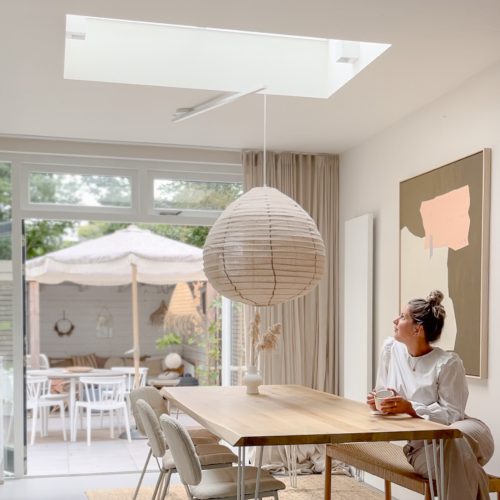
Enjoy your Lightswing® right away
So you have time to think about it
We'll prepare your order the same day

Enjoy your Lightswing® right away
So you have time to think about it
We'll prepare your order the same day
Are you wondering whether the ceiling in your house is suitable for the Lightswing®? In this blog we tell you per ceiling type whether or not it is suitable for attaching the Lightswing®.


A thatched ceiling
Is there wood or plaster above the reeds? Make sure you screw the Lightswing® into the wood / plaster with the right plugs and screws. Does your thatched ceiling have no extra support (wood or plaster) under the reeds? Then it is unfortunately not possible to attach the Lightswing® to a thatched ceiling. Reed is not sturdy enough to carry the Lightswing® with the pendant lamp.
A concrete ceiling
A concrete ceiling is certainly suitable for attaching the Lightswing®. You cannot fully attach the Lightswing® to the central box, so keep in mind that you have to drill 4 holes in your concrete ceiling to be able to attach the system properly. For this we supply a handy drilling template in the Lightswing® package. So nothing can go wrong!
A wood or plaster ceiling
A wooden ceiling or a plaster ceiling is also suitable for the Lightswing®. If you have a plaster ceiling with no further support underneath (wood, for example), it is extra important to use the right plugs and screws. Make sure that the plugs go all the way through the plaster. So, the plug expands not only in the plaster, but also at the top of the drywall.
A sloping ceiling
It is possible to attach the Lightswing® to a slightly sloping ceiling. For this it is best to use a Lightswing® Twin. The Twin has an adjustable foot at both ends of the Lightswing®, so you can set the Lightswing® to the ceiling on both sides. Note: make sure that your pendant light does not hang at the lowest point. The Quick Release to which the lamp is attached is not locked in the Lightswing®. If the lamp is too heavy or the slope is too slanted, the Quick Release can come loose.
A ceiling with an ornament
It is possible to attach the Lightswing® to an ornament. With the help of the Lightswing® you can easily move the pendant lamp to the right place without loose cables hanging from the ornament. Use the mounting ring for this. This allows the Lightswing® to rotate and slide freely, without damaging the ornament.
A beamed ceiling
Do you have a beamed ceiling and do you want to attach a Lightswing®? Then there are a number of things you can consider. First of all, it is easiest when you mount the Lightswing® on the beams and not ‘between’ the beams. This gives the Lightswing® plenty of room to slide and rotate. Do you want to place the Lightswing® between the beams? Keep in mind that the Lightswing® does not have complete freedom to slide and rotate.
A skylight ceiling.
With the Lightswing® you can easily place your pendant lamp under the skylight. Connect the Lightswing® over the current light point next to the skylight. Because the system is only fixed at one point and can move freely, even if there is no ceiling above, you can easily place your pendant lamp under the skylight.
The Lightswing® is therefore suitable for almost all ceiling types. Have you already made a choice which Lightswing® you would choose? Check out the Lightswing® Single for one pendant light. Or check out the Lightswing® Twin so you can attach two pendant lights to your ceiling!